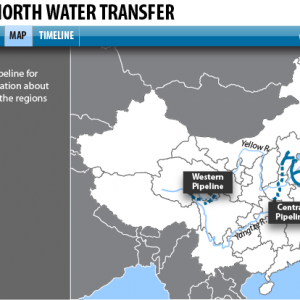Federal Water Tap, February 28: Energy Scrutiny
Desert Energy Development
Eagle Crest Energy is developing a 1,300-megawatt pumped storage hydroelectric project in southern California, south of Joshua Tree National Park. Sited at a decommissioned iron mine, the facility’s tiered reservoirs will help integrate nearby wind and solar power into the electrical grid. Water to fill the reservoirs will come from groundwater conveyed by a three-mile pipeline. The Federal Energy Regulatory Commission held information sessions in Riverside, California during the first week of February. The public comment period for the draft environmental impact statement ends February 28.
As The Turtle Moves
The Environmental Protection Agency released a draft version of how it will study the effects of hydraulic fracturing on drinking water—a plan for the plan of the study, if you will. Last year, congress directed the EPA to study the issue. Critics of the drilling method—which is called frackin and blasts a mixture of water, sand, and chemicals at shale deposits to release trapped gas—say that the wastewater contaminates drinking water sources. The agency will produce an interim report by 2012 and a follow-up report two years later. The scientific advisory board will review the draft plan by March 7 of this year, and public comments are being accepted until then. The study will begin promptly following the review. Meanwhile, fracking proceeds apace in more than a dozen states in the west, midwest and northeast.
Aquifer Depletion, But Not Where You’d Think
An assessment from the U.S. Geological Survey shows groundwater levels in some areas of the Northern Atlantic Coastal Plain Aquifer have dropped more than 100 feet since 1929, with declines most severe in southeastern Virginia. Stretching across one of the nation’s most populated areas—from Long Island, New York to North Carolina’s central coast—the aquifer is one of ten critical groundwater sources that the USGS is comprehensively cataloguing. To assess the aquifer’s health, further study of will incorporate water withdrawal data and flow models.
At The Sand Bar, Do They Serve A Dry Martini?
In 2004 and 2008, the U.S. Department of the Interior and the USGS conducted high-volume flow experiments at Arizona’s Glen Canyon Dam to test the effect on sandbars and fish populations. Designed to mimic floods that occurred before the Colorado River was dammed, the experimental flows increased sandbar volume but also increased the number of rainbow trout—a non-native species known to prey on the endangered humback chub. To set standards for future flow experiments, the U.S. Bureau of Reclamation has posted an environmental assessment, available for public comment until March 18.
Federal Water Tap is a weekly digest spotting trends in U.S. government water policy. To get more water news, follow Circle of Blue on Twitter and sign up for our newsletter.
Brett writes about agriculture, energy, infrastructure, and the politics and economics of water in the United States. He also writes the Federal Water Tap, Circle of Blue’s weekly digest of U.S. government water news. He is the winner of two Society of Environmental Journalists reporting awards, one of the top honors in American environmental journalism: first place for explanatory reporting for a series on septic system pollution in the United States(2016) and third place for beat reporting in a small market (2014). He received the Sierra Club’s Distinguished Service Award in 2018. Brett lives in Seattle, where he hikes the mountains and bakes pies. Contact Brett Walton






Leave a Reply
Want to join the discussion?Feel free to contribute!